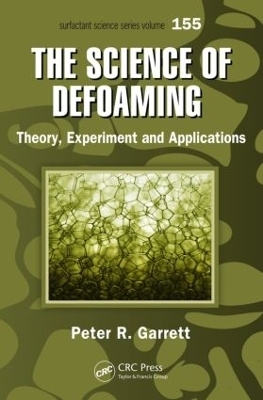
The Science of Defoaming
Crc Press Inc (Verlag)
978-1-4200-6041-6 (ISBN)
Since most commercially effective antifoams are oil based, a chapter is devoted to the entry and spreading behavior of oils and the role of thin film forces in determining that behavior. The book reviews the mode of action of antifoams, including theories of antifoam mechanisms and the role of bridging foam films by particles and oil drops. It also addresses issues related to the effect of antifoam concentration on foam formation by air entrainment and the process of deactivation of mixed oil–particle antifoams during dispersal and foam generation.
For applications where chemical antifoam use is unacceptable, the text examines mechanical means of defoaming, such as the use of rotary devices and ultrasound. The final chapters consider the application of defoaming in radically different contexts including waterborne latex paints and varnishes, machine washing of textiles, gas–oil separation in crude oil production, and cardiopulmonary bypass surgery. Focusing on the basic science of defoaming, this book presents a balanced view, which also addresses the challenges that may arise for these specific defoaming applications.
After working for Unilever Research for almost thirty years at Port Sunlight and for a short time at Bangalore, Peter Garrett retired, acquiring visiting professorships at the University of Manchester in the United Kingdom and briefly at Rice University, Houston, Texas. He has worked on various aspects of interfacial science in a career lasting 40 years. These included the equilibrium and dynamic adsorption behavior of surfactant solutions, solubilization in microemulsions, kinetics of surfactant dissolution and mesophase growth, and of course both the basic science of defoaming and its application especially in the detergents industry. Professor Garrett is author or coauthor of more than 30 journal articles and is named as inventor on 14 patents, the majority of which concerned the application of antifoam technology. He is also editor of the book Defoaming, Theory and Applications published in 1993. A member of the Royal Society of Chemistry, he received his Ph.D. from the University of Leicester in the United Kingdom in 1971.
Some General Properties of Foams. Experimental Methodologies for Study of Foam and Antifoam Action. Oils at Interfaces; Entry Coefficients, Spreading Coefficients, and Thin Film Forces. Mode of Action of Antifoams. Effect of Antifoam Concentration on Volumes of Foam Generated by Air Entrainment. Deactivation of Mixed Oil–Particle Antifoams During Dispersal And Foam Generation in Aqueous Media. Mechanical Methods for Defoaming. Antifoams for Detergent Products. The Control of Foam in Waterborne Latex Paints and Varnishes. Antifoams for Gas–Oil Separation in Crude Oil Production. Medical Applications of Defoaming.
| Erscheint lt. Verlag | 9.7.2013 |
|---|---|
| Zusatzinfo | 30 Tables, black and white; 229 Illustrations, black and white |
| Verlagsort | Bosa Roca |
| Sprache | englisch |
| Maße | 156 x 234 mm |
| Gewicht | 975 g |
| Themenwelt | Naturwissenschaften ► Biologie |
| Naturwissenschaften ► Chemie ► Physikalische Chemie | |
| Naturwissenschaften ► Chemie ► Technische Chemie | |
| Technik ► Umwelttechnik / Biotechnologie | |
| ISBN-10 | 1-4200-6041-4 / 1420060414 |
| ISBN-13 | 978-1-4200-6041-6 / 9781420060416 |
| Zustand | Neuware |
| Haben Sie eine Frage zum Produkt? |
aus dem Bereich


